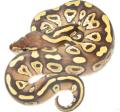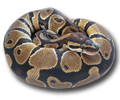» Site Navigation

0 members and 591 guests
No Members online
Most users ever online was 47,180, 07-16-2025 at 05:30 PM.
» Today's Birthdays

» Stats

Members: 75,912
Threads: 249,117
Posts: 2,572,189
Top Poster: JLC (31,651)
Welcome to our newest member, coda
|
-
Registered User


Re: "True" Axanthic Theory
-
-
Registered User


Re: "True" Axanthic Theory
Although the different lines act differently on the genetic pathway, they still produce the same result by blocking (or reducing) the production of red and yellow pigment. I honestly don't think it would be worth it. You would eventually end up with animals that you were unsure of their exact genetics.
Normal
---black------------yellow----------------red--------------------------->
Axanthic
---black------------yellow----------------red---------------------------->
-
-
Re: "True" Axanthic Theory
I agree with the above posters in that I expect that the "browning out" or "holding its color" traits are set by other genes inherited from the het parents/grandparents, rather than by any of the axanthic genes themselves. So I expect line breeding specimens that hold their color would be a better way to produce "true axanthics" than combining the different lines.
That said, I still think you should go for it! Just be careful while you're doing it that you don't ever mix up the tags marking which axanthic het-for-other-axanthic is in which tub... 
Last edited by loonunit; 05-20-2010 at 01:25 PM.
-Jackie Monk
-
-
Registered User

Re: "True" Axanthic Theory
As others have said, what you are proposing, wouldn't get you the results you truly are looking for.
All we need to look at are the two well known morphs dealing with an excess of yellow, or the limiting/lack of yellow (Pastel and Axanthic) and see that both have issues with animals aging and "Browning" out to show that the yellow pigment is not the issue when it comes to the browning out that happens.
The charcoal / black axanthics are a very neat line as well, but I think what we are seeing here is hypermelanism(Excess black pigment) combined with axanthicism (lacking yellow) to produce a very black and "white" animal.
Truth be told, what your best bet would be, as others have said would be to combine an axanthic line, with the fire (het lucy) trait. Fires and Vanillas have both been shown to stay "clean" as they age meaning the browns do not come in.
Another option would even be to throw in the pastel mutation as well to increase the yellow concentration, the axanthic mutation to wash out the yellow, and the fire/vanilla mutations (yes they are different, not same thing) to keep the animal "clean" into adulthood avoiding the browning out that is common with both axanthics and pastels. I don't necessarily think that axanthics or pastels cause the browning out, only that they make it more noticeable than the wild types maturing into their brown colors.
Hope that helps  
-
-
Registered User


Re: "True" Axanthic Theory
 Originally Posted by Mahlon

As others have said, what you are proposing, wouldn't get you the results you truly are looking for.
All we need to look at are the two well known morphs dealing with an excess of yellow, or the limiting/lack of yellow (Pastel and Axanthic) and see that both have issues with animals aging and "Browning" out to show that the yellow pigment is not the issue when it comes to the browning out that happens.
The charcoal / black axanthics are a very neat line as well, but I think what we are seeing here is hypermelanism(Excess black pigment) combined with axanthicism (lacking yellow) to produce a very black and "white" animal.
Truth be told, what your best bet would be, as others have said would be to combine an axanthic line, with the fire (het lucy) trait. Fires and Vanillas have both been shown to stay "clean" as they age meaning the browns do not come in.
Another option would even be to throw in the pastel mutation as well to increase the yellow concentration, the axanthic mutation to wash out the yellow, and the fire/vanilla mutations (yes they are different, not same thing) to keep the animal "clean" into adulthood avoiding the browning out that is common with both axanthics and pastels. I don't necessarily think that axanthics or pastels cause the browning out, only that they make it more noticeable than the wild types maturing into their brown colors.
Hope that helps  
very well said! 
Visit my blog sometime! Fadere's Cirque du Chaos 
0.2 Normal Ball (Buttery McMuffintop aka Freddie, Slender Q. Thunderpants aka Slim)
0.1 DSH Housecat (Loki aka Wafflenoggin)
-
-
Re: "True" Axanthic Theory
Wow guys, necro thread. :p
Although I would still be curious to see the resulting animals of the 3 known incompatible Axanthic blood lines, I don't think it'd be worth the trouble of combining 3 recessive genes (Triple Het x Triple Het is 1:64 Odds).
That said I need to get an updated picture of my Jolliff Axanthic, he's 500 Grams now and just as beautiful as he ever was! (Just as mean too!)
-
-
Registered User

Re: "True" Axanthic Theory
 Originally Posted by NorthernRegius

How does that increase the Black & white contrast in an Axanthic? If you want the brown suppressed why not pick higher yellow morphs that don't show brown & then use the Axanthic to erase the yellow? Wouldn't that work?
I would agree with you. In fact, my personal thought is, why not cross, an axanthic pastel, with an axanthic fire, making an axanthic firefly, which is renowned for brightening as it gets older. Should this not, in theory, keep the animal from browning out with age?? This is of course, just a theory, but who knows?
Also why not simply cross a TSK, with a VPI, and see what the offspring look like. If they look like Oakland Raiders, then we have a compatible cross, if not, we dont. From there, if the offspring look like normals, then we can assume them to be double hets, so we then cross the children to each other, and we can see what the result would then be.
-
-
Registered User

Would love to see a VPI Joaliff or Joaliff VPI AXN sitting next to his grandparents. Anyone? 
-
 Posting Permissions
Posting Permissions
- You may not post new threads
- You may not post replies
- You may not post attachments
- You may not edit your posts
-
Forum Rules
|